Photograms, from Man Ray to Thomas Ruff
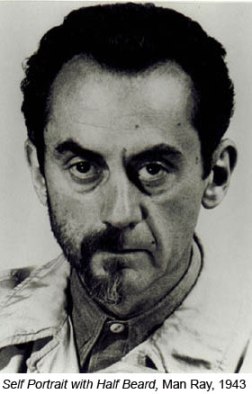 Recently I’ve been reading Man Ray’s 1963 autobiography,
Self Portrait
, as research for my fiction. It’s an interesting read on many levels. The child of poor Russian Jewish immigrants, Ray became an important member of Dada and Surrealist art circles in New York and Paris. His Surrealist photography was stunning and highly influential, and his love affairs with beautiful women like Kiki de Montparnasse and Lee Miller are the stuff of legend.
Recently I’ve been reading Man Ray’s 1963 autobiography,
Self Portrait
, as research for my fiction. It’s an interesting read on many levels. The child of poor Russian Jewish immigrants, Ray became an important member of Dada and Surrealist art circles in New York and Paris. His Surrealist photography was stunning and highly influential, and his love affairs with beautiful women like Kiki de Montparnasse and Lee Miller are the stuff of legend.
Yet when he lived in Paris in the 1920s, Ray came close to being just one more failed expat American artist. At the time, he was focused on becoming a painter, but his paintings didn’t garner much interest. Back in New York, he’d used a camera to make prints of the work of artist friends like Marcel Duchamp, and also some photo portraits (including one of Berenice Abbott, who later became his assistant in Paris), but he didn’t really regard himself as a photographer. It was only when his painting failed that he took up the camera more seriously.
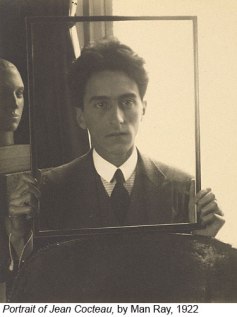 The turning point came when Ray’s friend, Francis Picabia, introduced him to Jean Cocteau. A poet and playwright, Cocteau was a celebrated man-about-town who was, in Ray’s words, “a social idol.” After Ray took a successful portrait of Cocteau, the Frenchman began bringing his writer and musician friends to Ray’s hotel room to pose for their portraits. In those beginning years, says Ray, “there was no question of payment… as Gertrude Stein said to me, we were all artists, hard up.” However, though no-one paid for the prints, “my files became very imposing and my reputation grew.”
The turning point came when Ray’s friend, Francis Picabia, introduced him to Jean Cocteau. A poet and playwright, Cocteau was a celebrated man-about-town who was, in Ray’s words, “a social idol.” After Ray took a successful portrait of Cocteau, the Frenchman began bringing his writer and musician friends to Ray’s hotel room to pose for their portraits. In those beginning years, says Ray, “there was no question of payment… as Gertrude Stein said to me, we were all artists, hard up.” However, though no-one paid for the prints, “my files became very imposing and my reputation grew.”
Ray might have stayed just that, an accomplished portrait photographer and sometime painter, if not for an apparent accident that happened in his darkroom one night. According to his account, he was making some prints of fashion photos he’d shot for a designer when one of the sheets of photo paper he’d put into the developer came up blank; he’d forgotten to expose it. “As I waited in vain a couple of minutes for an image to appear, regretting the waste of paper, I mechanically placed a small glass funnel, the graduate and the thermometer in the tray on the wetted paper,” Ray writes. “I turned on the light; before my eyes an image began to form, not quite a simple silhouette of the objects as in a straight photograph, but distorted and refracted by the glass more or less in contact with the paper and standing out against a black background, the part directly exposed to the light.”
Photograms were not entirely new. William Henry Fox Talbot created some of the first photographic prints by laying leaves and ferns on photo-sensitive paper and exposing it in sunlight. Nineteenth century botanist Anna Atkins used cyanotypes to create beautiful blueprints of plants and flowers. And a year or two before Ray, accomplished German painter Christian Schad had experimented with photograms, calling his results Schadographs.
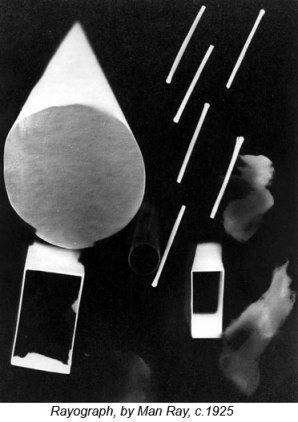 As Ray tells it, his friend
Tristan Tzara
, the leader of the Dadaist movement, came over the next morning and pronounced Ray’s photograms “pure Dada creations.” Tzara knew about Schad’s experiments, and had brought some of them to Paris. It’s possible Man Ray had seen them, but he doesn’t admit to this in his book, clearly wanting to be the progenitor of the genre. Instead, he recounts that Tzara told him his work was “far superior to similar attempts–simple flat textural prints in black and white–made a few years ago by Christian Schad, an early Dadaist.” Schad almost certainly gave Ray one idea, though: Ray called his photograms Rayographs, just as Schad had dubbed his Schadographs.
As Ray tells it, his friend
Tristan Tzara
, the leader of the Dadaist movement, came over the next morning and pronounced Ray’s photograms “pure Dada creations.” Tzara knew about Schad’s experiments, and had brought some of them to Paris. It’s possible Man Ray had seen them, but he doesn’t admit to this in his book, clearly wanting to be the progenitor of the genre. Instead, he recounts that Tzara told him his work was “far superior to similar attempts–simple flat textural prints in black and white–made a few years ago by Christian Schad, an early Dadaist.” Schad almost certainly gave Ray one idea, though: Ray called his photograms Rayographs, just as Schad had dubbed his Schadographs.
Whatever the truth, one thing is certain: the Rayographs were an instant hit. “An editor of a literary and art magazine took some prints for publication, Cocteau asked me to make a frontispiece for a deluxe book of poems he was bringing out; it had to be a Rayograph,” Ray writes. “The next few weeks I was very busy… more writers, painters and musicians came to see my Rayographs, bringing me books and sketches, inviting me to concerts of modern music.”
Why all the excitement? According to Ray, his Rayographs “looked startlingly new and mysterious.” The random collections of unconnected objects like scissors, springs, film strips and gyroscopes spoke to a modernist sensibility in which reality was haphazard and fractured. Ray was good at composition, too, and as this page shows, there was an elegance and beauty to his work that was perhaps not achieved so well by Schad and another contemporary, Lazlo Moholy-Nagy .
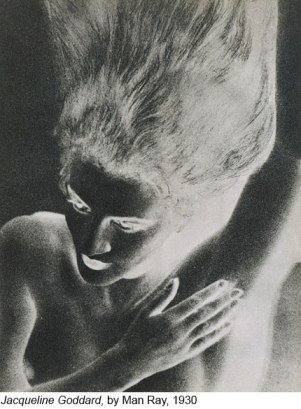 For Ray, it was an artistic breakthrough. The creativity he used in his initial photograms would inspire him to think outside the box. He went on to use human subjects in his Rayographs (see above), and also to create great Surrealist images like his celebrated
Le Violon d’Ingres
(below) and solarized portraits of
Jacqueline Goddard
and
Lee Miller
.
For Ray, it was an artistic breakthrough. The creativity he used in his initial photograms would inspire him to think outside the box. He went on to use human subjects in his Rayographs (see above), and also to create great Surrealist images like his celebrated
Le Violon d’Ingres
(below) and solarized portraits of
Jacqueline Goddard
and
Lee Miller
.
One has to take Ray’s description of his discovery with a pinch of salt. Self Portrait is a highly selective and often self-congratulatory version of his life. He credits himself with influencing many major artists, saying, “I have no doubt that the procession of my contemporaries who filed through my studio could not help being inspired, at least stimulated by its atmosphere.” He writes with apparent pride about domestic violence he inflicted on two separate women, and completely fails to mention his artistic split with Berenice Abbott or his love affair and artistic collaboration with Lee Miller. Perhaps most notably, in a section titled “Occupations and Evasions” he recounts his 1940 escape from France without once mentioning his Jewish background. Evasive, indeed.
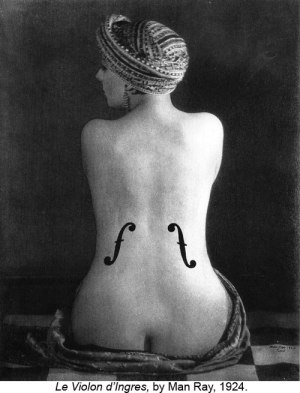 Still, there’s no doubt that Ray was a great avant-garde artist, and that his influence endures. The latest artist to pay tribute to Ray is German photographer
Thomas Ruff
, who
recently exhibited
his digital photograms at the
David Zwirner Gallery
New York.
Still, there’s no doubt that Ray was a great avant-garde artist, and that his influence endures. The latest artist to pay tribute to Ray is German photographer
Thomas Ruff
, who
recently exhibited
his digital photograms at the
David Zwirner Gallery
New York.
Using digital technology, Ruff has taken photograms to the next level–preserving the beauty of Ray’s vision while moving the genre into the digital era. “Of course, it’s a bit absurd to use this new technology to create images that look like they’re from the 1920s,” he said at the exhibition press briefing. “But the nice thing about the virtual darkroom is that you can decide on the level of transparency for each object, to get various shadows and reflections.”
I’m not going to go into a lot of detail about how Ruff creates his digital photograms because, frankly, I didn’t really understand it. From what I remember, it seems that the objects in the images are created in Cinema 4D, a program that renders them three-dimensionally so that artificial light rays can then be produced and aimed at them. Ruff seems to go to certain lengths to make the lighting seem accurate, but he also enjoys the fact that he can do things Ray and Schad could not—like adding color and printing the work at a large scale.
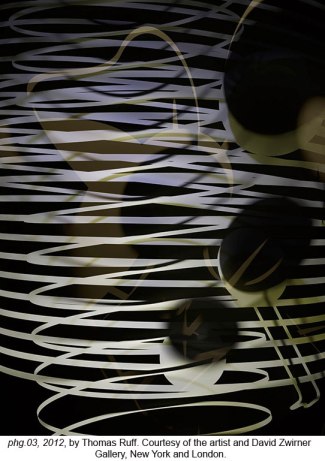 In an interview after the press briefing, Ruff–who, thankfully, doesn’t call his images Ruffographs–told me he created this work because of his love of photograms. “In the 1920s this was a big thing, bringing abstraction into photography,” he said. “It was a challenge to see if I could make the next generation.”
In an interview after the press briefing, Ruff–who, thankfully, doesn’t call his images Ruffographs–told me he created this work because of his love of photograms. “In the 1920s this was a big thing, bringing abstraction into photography,” he said. “It was a challenge to see if I could make the next generation.”
I think Ruff’s riff on the photogram is very successful. I’m not a fan of all his work, but this series has the abstract delicacy and compositional beauty of Ray’s work, while also translating the genre into the realm of bits and bytes. “I wanted to revive this, and make it into art so that people wouldn’t forget about it,” Ruff said. During this time of digital transition it’s nice to see an artist using technology thoughtfully, making reference to photographic history and forging a link between past and present.
——————————————————————————
N.B. I’ll be posting less often over the summer as I gather all my resources to finish my novel revision. Look for two or three posts in July and August, and then resumption of biweekly posts in September. Thanks and have a great summer!
13 comments on “ Photograms, from Man Ray to Thomas Ruff ”
Leave a Reply
Connecting to %s


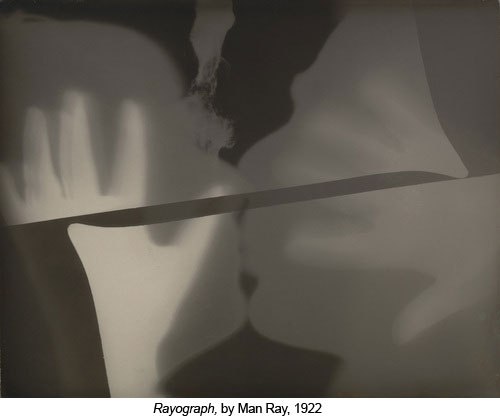
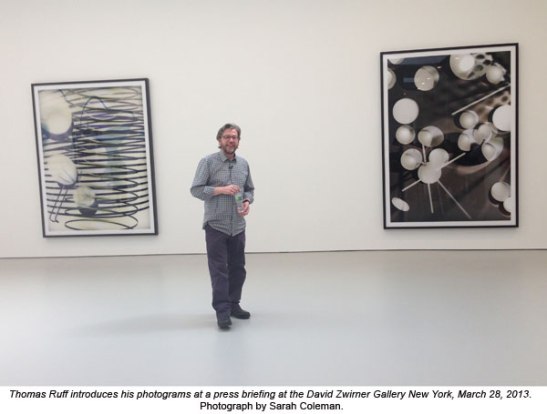

Hi Sarah:
This is a wonderful review! I will also read Man Ray’s autobiography.
I linked to it here: https://www.facebook.com/andrewdarlow/posts/10151505261289632
All the best,
Andrew
Thanks Andrew!
Fascinating!
Had no idea about the history of photograms. Fascinating stuff, Sarah!
This really is a great review, thanks very much
You’re welcome, Cordelia! Thanks for reading.
Great piece as always Sarah!
A fantastic review on Man Ray, could not agree more on your historical interpretation of events. With Thomas Ruff, you were very polite, but still reading between the lines communicating. Message received.
Thanks, Jeremy! Appreciate your comments.
Really interesting post, thanks. I’ve been pondering photograms recently (partly because some of my students have been making them but also because I posted a piece about William Wegman’s work and one of his dogs was called Man Ray) but haven’t come across the Thomas Ruff digital photograms before. They look interesting both as works but also conceptually; I really like the idea that he’s reinventing the most analogue of processes digitally. And yes, definitely good that he’s not calling them Ruffograms. I wonder if he was tempted!
Thanks, Ann! Glad you enjoyed it. Can you post a link to your piece on William Wegman?
Of course! Here it is: http://imageobjecttext.com/2014/01/18/posing-pooches/
Reblogged this on Hello from me to you .